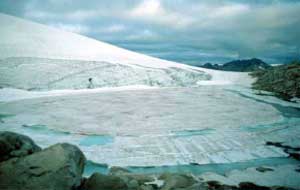| Natural Notes |
National Park Service U.S. Department of the Interior 2002-2003 North Cascades National Park Service Complex |

|
Glaciers in the Cascades
Understanding Nature's Frozen Sculptors
|
One of the most striking features of the North Cascades is the incredible number of glaciers in the region. Boasting more than 300 glaciers and countless snowfields, the North Cascades National Park Service Complex is the most heavily glaciated area in the United States outside of Alaska.
The glaciers are a vital component of the North Cascades ecosystem. They influence soil development, vegetation distribution and flooding and are unique indicators of climatic change. Glaciers are formed when more snow accumulates in winter than melts or evaporates during the following summer. The immense weight of this continuous buildup causes the snow to compact into ice, which then slowly moves downhill. As glaciers move, they gouge and scrape the landscape, continuously redefining it. Mountains may appear to be in suspended animation, but like everything else, they are in a continuous state of change.
The North Cascades glaciers are disappearing. Since the mid-19th century, most glaciers in this area have shrunk dramatically. This is due to the combined effect of less precipitation and warmer summers. More than 90 percent of the North Cascades glaciers could disappear within 40 years if the annual temperature increases by 2 degrees Celsius (3.6 degrees Fahrenheit). People in the North Cascades recognize that if glaciers continue to shrink, substantial adjustments to lifestyles, agriculture and industry will be necessary. Salmon and other aquatic life also would encounter difficulties if the glaciers disappear. Life changes as a result of climate change; glaciers mirror these trends. Glaciers are indicators of climate changes such as temperature and precipitation. As reservoirs of snow from past winters, they can show concentrations of airborne pollutants trapped in their ice. Subsequent snow melt may wash the pollutants into lakes and streams where they are absorbed by insects and move through the food chain affecting everything from amphibians to fish and fish eaters including humans.
Several related projects are helping scientists understand the ecological importance and changing nature of the park's glaciers. Data collection on the Noisy, Silver, North Klawatti, and Sandalee glaciers provides valuable information about the climate of the North Cascades as well as the amount and timing of meltwater released by glaciers. Through these studies, park managers are developing a greater understanding of the glaciers' ecological role and function and are educating the public. For more information visit http://www.nps.gov/noca/massbalance.htm and http://www.earthwatch.org/expeditions/skagit.html. |
| <<< Previous | > Cover Page < | Next >>> |


